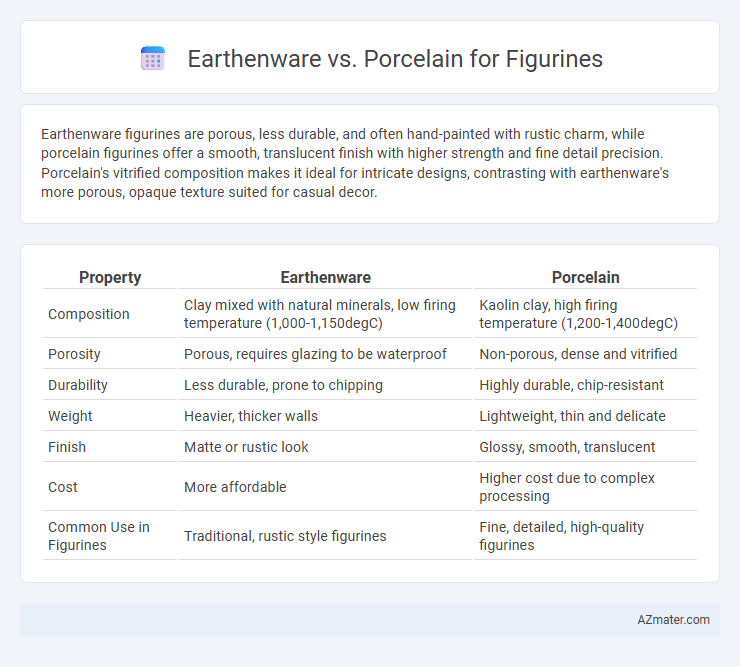Earthenware figurines are porous, less durable, and often hand-painted with rustic charm, while porcelain figurines offer a smooth, translucent finish with higher strength and fine detail precision. Porcelain's vitrified composition makes it ideal for intricate designs, contrasting with earthenware's more porous, opaque texture suited for casual decor.
Table of Comparison
| Property | Earthenware | Porcelain |
|---|---|---|
| Composition | Clay mixed with natural minerals, low firing temperature (1,000-1,150degC) | Kaolin clay, high firing temperature (1,200-1,400degC) |
| Porosity | Porous, requires glazing to be waterproof | Non-porous, dense and vitrified |
| Durability | Less durable, prone to chipping | Highly durable, chip-resistant |
| Weight | Heavier, thicker walls | Lightweight, thin and delicate |
| Finish | Matte or rustic look | Glossy, smooth, translucent |
| Cost | More affordable | Higher cost due to complex processing |
| Common Use in Figurines | Traditional, rustic style figurines | Fine, detailed, high-quality figurines |
Understanding Earthenware and Porcelain: Key Differences
Earthenware figurines are made from porous clay fired at lower temperatures (typically between 1,000degC and 1,150degC), resulting in a softer, more porous texture that requires sealing to prevent moisture absorption. Porcelain figurines, crafted from fine kaolin clay and fired at higher temperatures (around 1,200degC to 1,400degC), exhibit a dense, vitrified, and translucent finish that enhances durability and intricate detail. The key differences lie in firing temperature, material composition, porosity, and surface finish, influencing the figurine's strength, appearance, and maintenance needs.
Material Composition: Earthenware vs Porcelain
Earthenware figurines are made from a porous clay fired at lower temperatures, typically between 1,000degC and 1,150degC, resulting in a softer, more porous material that requires glazing to prevent water absorption. Porcelain figurines consist of a refined clay mixture containing kaolin, fired at much higher temperatures around 1,200degC to 1,400degC, producing a dense, non-porous, and translucent material known for its strength and delicate appearance. The difference in firing temperatures and raw materials directly affects the durability, texture, and finish of earthenware versus porcelain figurines.
Strength and Durability Comparison
Porcelain figurines exhibit superior strength and durability compared to earthenware due to their higher firing temperatures and vitrification process, resulting in a dense, non-porous structure resistant to chipping and cracking. Earthenware, fired at lower temperatures, remains more porous and fragile, making it prone to breakage and less suitable for intricate, delicate figurines. The enhanced hardness and durability of porcelain ensure long-lasting preservation and resistance to wear, crucial for collectible and decorative figurines.
Detail and Finish: Sculpting Capabilities
Porcelain figurines offer superior sculpting capabilities due to their fine-grain composition, allowing intricate details and smooth finishes that enhance delicate features and textures. Earthenware tends to have a coarser texture, limiting the level of detail achievable and often resulting in a more rustic or matte finish. The high firing temperature of porcelain contributes to its hardness and translucency, making it ideal for finely crafted, detailed figurines.
Firing Temperature and Production Techniques
Earthenware figurines are fired at lower temperatures between 1,000degC and 1,150degC, resulting in a porous, softer finish that requires glazing for durability. Porcelain figurines undergo high-temperature firing around 1,200degC to 1,450degC, producing a dense, vitrified, and translucent body prized for fine detail and strength. Production techniques for earthenware involve simpler molding and glazing processes, while porcelain demands refined casting methods and multiple firings to achieve its delicate finish and smooth surface.
Glazing and Surface Textures
Earthenware figurines typically feature a porous surface that absorbs glaze, resulting in a thicker, often matte finish with vibrant colors but less durability. Porcelain figurines have a dense, non-porous surface that allows for a smooth, glass-like glaze with a glossy, refined texture and greater resistance to chipping. The glazing on porcelain enhances intricate details due to its thin, even application, while earthenware glazing can obscure fine textures because of its more uneven absorption.
Color and Aesthetic Qualities
Earthenware figurines exhibit warm, earthy tones and a slightly porous surface that enhances rustic and handcrafted aesthetics. Porcelain figurines offer a smooth, glossy finish with a translucent quality, allowing for vibrant, detailed color applications and refined elegance. The choice between earthenware and porcelain significantly impacts the visual appeal, with earthenware emphasizing natural textures and porcelain showcasing delicate, luminous beauty.
Price Differences: Affordability and Value
Earthenware figurines typically cost less due to their lower manufacturing temperature and more porous nature, making them a budget-friendly option for collectors. In contrast, porcelain figurines are more expensive, reflecting their higher kiln temperatures, refined materials, and durability, offering long-term value and intricate detailing. Price differences are influenced by the density, translucency, and finish quality, with porcelain considered a premium choice for investment and display.
Best Uses: Choosing the Right Material for Figurines
Earthenware offers excellent versatility and affordability for large, decorative figurines and outdoor sculptures due to its porous nature and rustic appeal. Porcelain, with its fine, smooth texture and high durability, is ideal for intricate, delicate figurines and collectible items requiring detailed craftsmanship and a refined finish. Selecting the right material depends on the desired aesthetic, durability, and display environment of the figurine.
Care, Maintenance, and Longevity
Earthenware figurines require gentle cleaning with a soft, damp cloth to avoid damage due to their porous and fragile nature, and they should be kept in stable, moderate humidity conditions to prevent cracking. Porcelain figurines offer superior durability and non-porous surfaces, allowing for easier maintenance with mild detergents and minimal risk of staining or water absorption. Long-term preservation of porcelain is enhanced by avoiding abrupt temperature changes and protecting from direct sunlight to prevent fading, while earthenware demands more careful handling to maintain structural integrity over time.

Infographic: Earthenware vs Porcelain for Figurine
 azmater.com
azmater.com